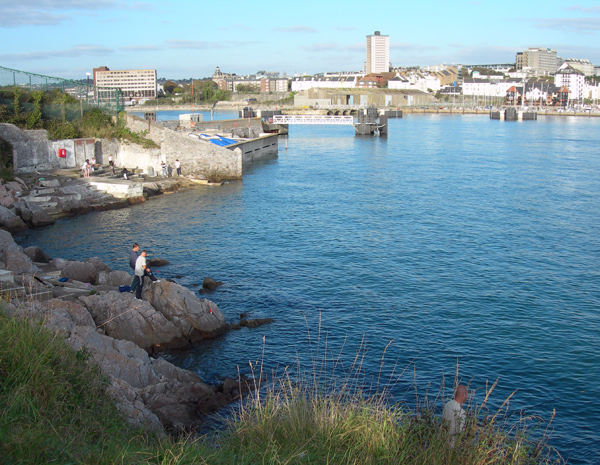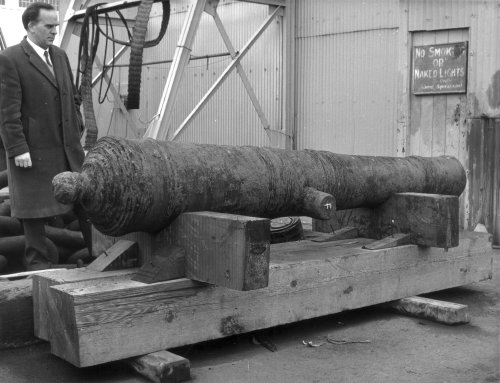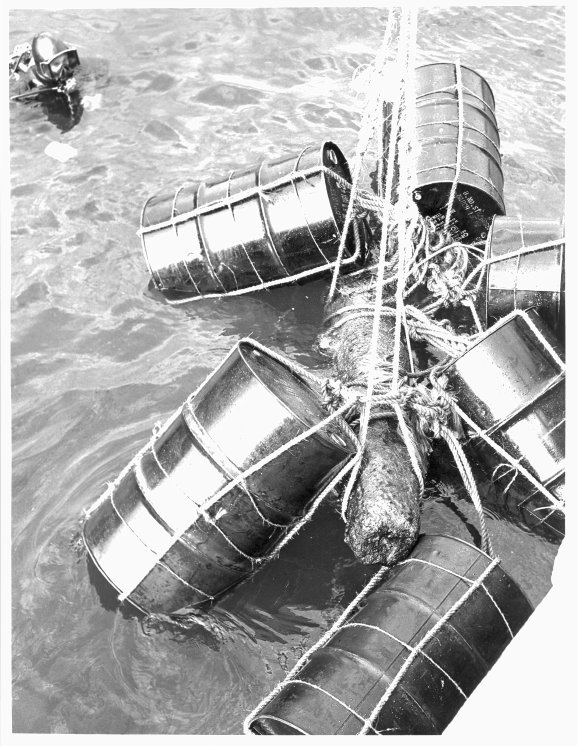The Millbay Cannon Site
In September 1967, diver Terence Lamb was searching the seabed off Millbay Docks at the northern end of Plymouth Sound when he came across some cannon balls and three large iron muzzle-loading cannons. Terence decided to bring one of the cannonballs up to the surface then took it to the local museum in the hope that it could be identified, the museum suggested it was 17th century and may be associated with the siege of Plymouth in 1642. Terry was a member of the local BSAC diving club and when other members got interested in his find they decided to survey the area where the guns were found. The Plymouth Sound Branch team were joined by pioneer underwater archaeologist Lt. Cdr. Alan Bax who brought along Navy divers from HMS Rhyl and over the winter of 1967-68 the combined survey team started to map the extent of the site.
The first expedition took place in November and they started to lay ground lines that would be used to make a scale plan of the site. Shortly after the first lines were laid, local salvor Silas Oates recovered three of the cannons from the site, claiming that he had found the site and that he had permission from the Queens Harbour Master. The act was condemned in the local press by the divers who stated that such irresponsible diving had ruined efforts made by the club(3), negotiations with the Harbour Master then stopped any further salvage work and the team were left to carry on their work. The guns were presented to the Navy and were transferred fresh water tanks in the South Yard of Devonport Dockyard.
The team wanted to learn more about the guns, cannonballs and other objects they found on the seabed but working on the site was difficult as the visibility was often poor and the wreck remains are almost completely buried in the seabed and hidden by weed. The divers had to work out how to search for objects, survey the site, label the guns, sketch and measure underwater as very little archaeological work had been done underwater by 1968. Fortunately, Alan Bax was a pioneer in the field and had set up the School for Nautical Archaeology Plymouth (SNAP) to train divers to record shipwrecks, and with Jim Gill writing one of the earliest manuals on underwater archaeology (6). The experimental work on this site also included the use of a marine magnetometer to find the location of iron objects on the seabed and the use of 3D scales for photographic recording of finds.
The Western Evening Herald championed the branch, stating the BSAC club: “… unlike some present day ‘pirates’ they do not expect to get rich from their endeavours – except in enhanced knowledge”. The newspaper also noted that there was a distinct absence of law encouraging the preservation of wrecks (5), and although today we have the Protection of Wrecks Act (1973) and the Protection of Military Remains Act (1986) many still believe that historic wrecks are there to be plundered rather than be understood.
Most of the guns that were found were around 7ft 10in long with a base ring diameter of 18in, although one gun was smaller at 6ft 9in and with a base ring diameter of only 11.5in. The guns that had been salvaged were cleaned of concretion and showed characteristic broad bands around the barrel either side of low mounted trunnions. Cannon expert Colin Carpenter was working with the team and wrote to a Danish museum hoping to identify the guns that the salvors had recovered. The director of the museum identified the guns as being Swedish Finbankers, cast between 1680 and 1715 and possibly made in Finspong in Sweden as some had trunnions marked with an ‘F’. Unfortunately, thousands of this type of cannon were exported all over Europe, so an identification of the ship wrecked off Millbay was no nearer. The three guns in the Dockyard were in poor condition and in need of conservation, eventually they were forgotten and ended up buried in the foundations of a new building.
In 1973 a team of Royal Marine divers from 42 Commando raised one of the guns but were then told to put it back as they had looted an archaeological site. The Millbay cannon site was re-surveyed in 1989 by Peter McBride and has been periodically visited by divers ever since. Peter McBride believes that the wreck may that of the Dutch man-of-war Waapen Mickmore, wrecked in a gale after dragging her anchors in the late 17th century.
Diving the Millbay Cannon Site
The cannon site lies 30m south of Millbay Pier in only a few metres of water with six 7ft long iron guns in an area approximately 15m by 30m. The guns lie mostly buried in a stony seabed covered with a thin layer of silt and hidden under weeds, so disturbing the seabed reduces visibility quite quickly. The site can be dived from the shore or by boat, shore divers can park cars near the Artillery Tower then walk 500m along the coast path to the bathing area where there are steps to get into the water. Care must be taken here as the site is next to the main shipping channel and next to Millbay docks so boat traffic is a problem. Permission to dive should be obtained from the Queens Harbour Master as they will be aware of any planned ship movements. The visibility is usually best at high water slack, diving off slack is not recommended as the outgoing current will take you across Millbay docks and an incoming current may take you into the main shipping channel.
![]() If you have any more information about this ship then please contact us.
If you have any more information about this ship then please contact us.
Images
The site lies to the south of Millbay Pier (SHIPS Project) |
Colin Carpenter inspecting one of the salvaged Finbanker guns (Bax Archive) |
Royal Marines raise one of the guns in 1973 (Bax Archive) |



